 |
 |
|
 |
 |
Training the 85th: Official Unit History
Official Unit History: Second Army Maneuvers
 The battalion’s first bridge was constructed on the Oauchita River
The battalion’s first bridge was constructed on the Oauchita River
The next six weeks after receipt of the fillers were spent on an intensive training program; drivers had to be
trained to handle the large Mack tractors with their long semi-trailer loads and men had to familiarize themselves with the equipment while the battalion was being equipped. - 8/3/41 Nazi siege of Leningrad begins.
The unit was then ordered to the Second Army Maneuvers which were to be held in the Arkansas-Louisiana Area. On August 28, 1941 it was at Lake Village, Arkansas and became engaged in the maneuvers.
The battalion’s first bridge was constructed on the Oauchita River in Arkansas; it was 550 feet long. Later during the maneuvers the battalion was
ordered to construct a bridge across the Red River at Campti, Louisiana. At this time a hurricane moving up from the Gulf of Mexico struck that area; hampered by the storm, the unstable red soil, and the swift river, the men constructed the bridge. After the
bridge had been completed, additional trestle spans had to be added because the river had risen because of the storm. When it was finally completed it was 1031 feet long which was the longest ponton bridge constructed by American Army Engineers since the Civil
War.
- 8/2/41 German advance on Moscow ( Operation Typhoon),
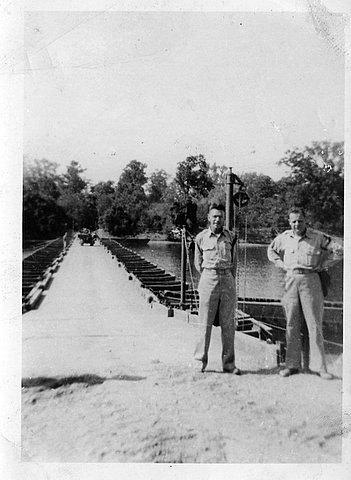 85th Medical: Dentist Silverstein and Dr. Bernstein at the Ouachita Bridge
85th Medical: Dentist Silverstein and Dr. Bernstein at the Ouachita Bridge
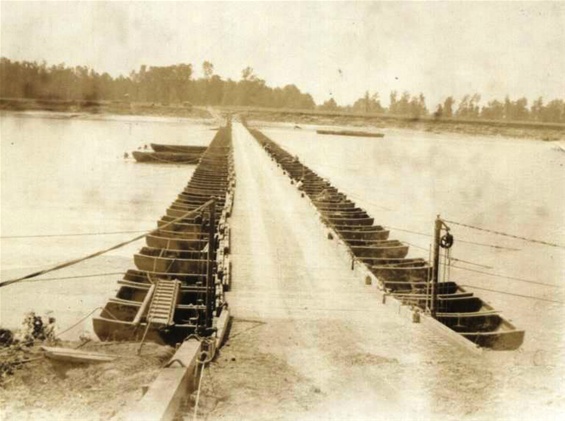 Red River Bridge
Red River Bridge
 At this time a hurricane moving up from the Gulf of Mexico struck that area; hampered by the storm, the unstable red soil, and the swift river, the men constructed the bridge.
At this time a hurricane moving up from the Gulf of Mexico struck that area; hampered by the storm, the unstable red soil, and the swift river, the men constructed the bridge.
Official Unit History: First Army Maneuvers
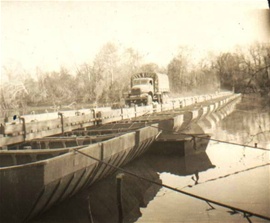 A number of bridges were built on the Pee Dee River during the First Army maneuver.
A number of bridges were built on the Pee Dee River during the First Army maneuver.
After completion of the Second Army Maneuvers, the unit was ordered to the First Army Maneuver Area in North and South Carolina; it arrived at its base camp at Ellerbe, North Carolina on October 12, 1941.
A number of bridges were built on the Pee Dee River during this maneuver. The First Army Engineer, Colonel R. T. Ward, commended the battalion for its excellent and meritorius work during the maneuver. - 12/6/41
Soviet Army launches major counter-offensive around Moscow. - 12/7/41 Japanese bomb Pearl Harbor. - 12/8/41 United States and Britian
declare war on Japan. - 12/11/41 Germany declares war on the United States, - 12/19/41 Hitler takes complete command of the German Army.
The battalion departed from the maneuver area and headed for the home station. On December 7, 1941, the day the Japanese struck, the battalion arrived at its home station, Fort Belvoir, Virginia, where it remained from the period December
8, 1941 until April 1, 1942. -1/26/42 First American forces arrive in Great Britian.
On February 13, 1942, the battalion was relieved
from assignment to the II Army Corps and was attached to the VI Army Corps. - 4/23/42 German air raids begin against cathedral cities in Britian.
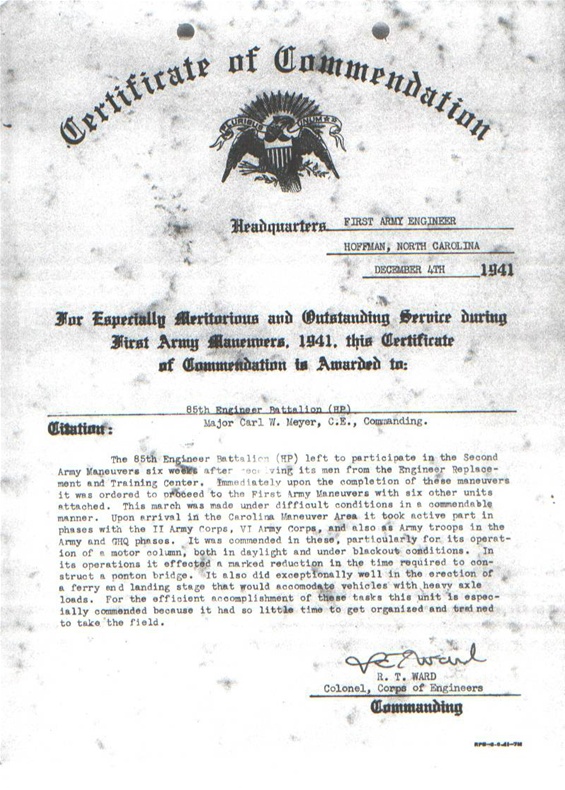 First Army Commendation
First Army Commendation
Official Unit History: Plattsburg Barracks
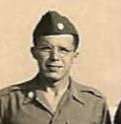 On May 20, 1942 Captain L. A. Perdue assumed command of the battalion. Later he would command the Battalion for the duration of its deployment in Europe.
On May 20, 1942 Captain L. A. Perdue assumed command of the battalion. Later he would command the Battalion for the duration of its deployment in Europe.
On April 2, 1942, the unit left Fort Belvoir by motor march for its new station, Plattsburg Barracks, New York and arrived on April 4,1942. - 6/42 Mass murder
of Jews by gassing begins at Auschwitz. - 6/21/42 Rommel captures Tobruk. - 6/25/42 Eisenhower arrives in London. - 6/30/42
Rommel reaches El Alamein near Cairo, Egypt.
From April until July the unit was engaged in an intensive training program which consisted of specialized training, bridge building, numerous marches,
and bivouacs. Full use was made of the facilities at Plattsburg such as Lake Champlain, Macomb Reservation and the islands in the lake.
On May 20, 1942, Lt. Col. Meyer was ordered to duty with
the 45th Division at Ft. Devens, Massachusetts and Captain L. A. Perdue assumed command of the battalion. On the 15th of June 1942, Major S. A. Armogida formerly Commanding Officer of the 180th Engineer Heavy Ponton Battalion which was also stationed at Plattsburg
Barracks, was assigned and assumed command of the battalion. - 7/1/42 First battle of El Alamein.
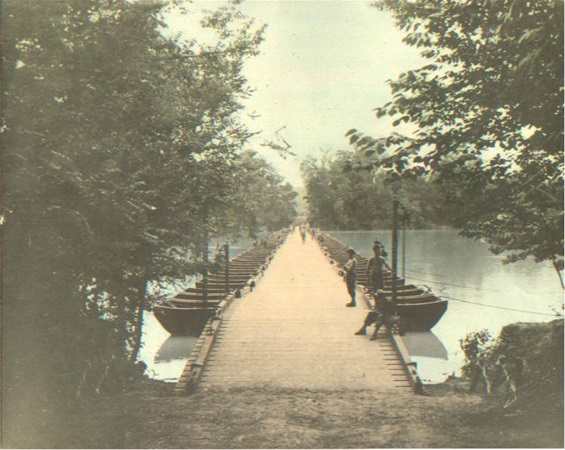 Rare color photo of the bridge training near Plattsburg
Rare color photo of the bridge training near Plattsburg
Official Unit History: North-South Carolina Maneuvers
 On the 5th of July, the rail loading was finished and the unit departed.
On the 5th of July, the rail loading was finished and the unit departed.
In June 1942, the battalion was ordered to the North-South Carolina maneuver area; on the 5th of July, the rail loading was finished and the unit departed. -
7/9/42 Germans begin a drive toward Stalingrad in the USSR.
During the first half of these maneuvers, the battalion was engaged in the instruction of other engineer units in heavy ponton construction;
during the latter half of the maneuvers the unit was actively engaged in bridge building and ferrying on the Pee Dee River. At the termination of the maneuvers, the battalion using its organic fixed bridging equipment, constructed a highway overpass near Marvin,
North Carolina to demonstrate the capabilities of heavy ponton equipage to Major General Dawley, Commanding General of the VI Army Corps. - 8/7/42 British General Bernard Montgomery takes command of 8th Army in North
Africa. - 8/12/42 Stalin and Churchill meet in Moscow. - 8/17/42 First all-American air attack in Europe.
On
August 21, 1943, the battalion began to move back to its home station, Plattsburg, by rail with the departure of H&S Company from Wadesboro, North Carolina. On the two succeeding days, B Company and A Company departed to return to the home station.
- 9/13/42 Battle of Stalingrad begins.
Once again at Plattsburg, an intensive training program was instituted. All the mistakes
and weak points were determined and corrective training started. Specialists were trained to fill the vacancies; all men went through a cycle of bridge training in order to make evey man familiar with the bridge. Several cadres had been sent out during and
after maneuvers, and numerous men had gone to Officers Candidate School with the result that the battalion was considerably understrength; at the time replacements were requisistioned and 67 men were received from the Reception Center at Fort Niagara on September
27, 1942.
The recruits posed a problem, it was solved however by setting up a provisional recruit company for the purpose of training these men. The preparation for these recruits was thorough;
a cadre had been drawn from the entire battalion; two officers were placed on special duty with this detachment. This recruit company was separate from any other company.
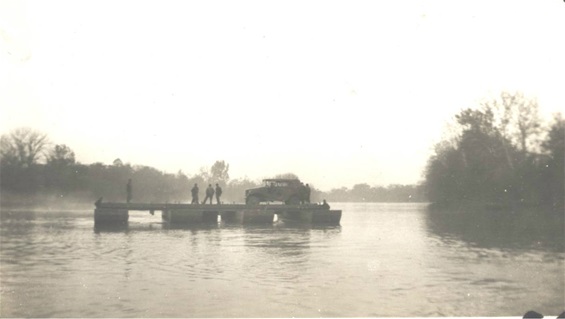 Ferrying on the Pee Dee River
Ferrying on the Pee Dee River
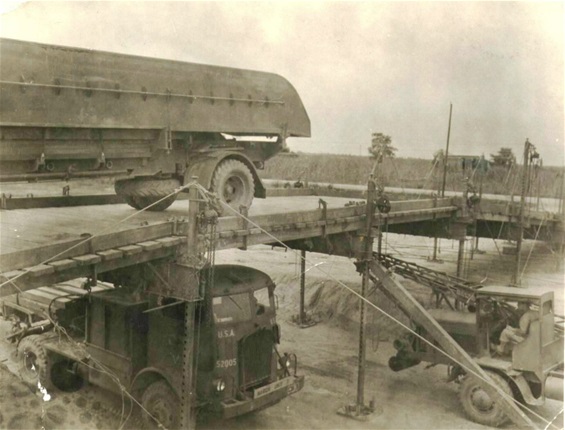 Highway overpass construction
Highway overpass construction
Official Unit History: Camp Maxey, Texas
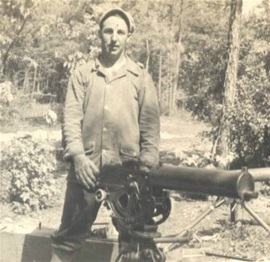 The training program at Maxey included the firing of the rifle, the .30 and .50 caliber machine guns, pistols and sub-machine guns.
The training program at Maxey included the firing of the rifle, the .30 and .50 caliber machine guns, pistols and sub-machine guns.
Late in September the battalion was ordered to change its station from Plattsburg Barracks, New York to Camp Maxey, Texas. Upon arrival of the battalion on October 14, 1942, it was relieved from attachment
to the VI Corps and attached to I Corps.
At Camp Maxey the unit started the most intensive training program it had participated in; full use was made of all the ranges and training facilities
and nearby Lake Gibbons. It was here that the recruits finished their training. - 11/8/42 Operation Torch begins (U.S. invasion of North Africa), - 11/19/42 Soviet counter-offensive
at Stalingrad begins.
Again in December 1942 the unit received recruits, this time there were 70 in number. Once again a recruit detachment was set up. However, this time the enlisted cadre was
furnished entirely by B Company. These men completed their eight week basic training on January 30, 1943. 1/14/43 Casablanca conference between Churchill and Roosevelt.
On January 20, 1943, Major Armogida was ordered to duty with the 553rd Engineer Heavy Ponton Battalion and departed for Camp Swift, Texas, the home station of that unit. Again, Major L. A. Perdue assumed command of the battalion.
- 1/23/43 Montgomery's 8th Army takes Tripoli. - 1/27/43 First bombing raid by Americans on Germany. - 2/14/43 Battle of Kasserine Pass
between U.S. 1st Armored and Germans.
The battalion was relieved from attachment to X Corps and was attached to 9th Hq, Third Army Special Troops February 1, 1943. It was assigned to Third Army
on February 20, 1943.
The training program at Maxey included the firing of the rifle, the .30 and .50 caliber machine guns, pistols and sub-machine guns. Two three weeks driver’s courses
have been conducted for beginners in addition to the numerous one week driver’s refresher courses all of which proved emminiently successful; tractor and angle dozer students had field days in leveling the rolling ground in order to make drill fields.
Lakes Lamar and Gibbons have served to train outboard motor operators, storm boat operators and the utility boat operators; while others were building the ponton bridge, foot bridge and the infantry support rafts on these bodies of water. In every way, the
battalion was given a well rounded and thorough training program. - 4/6/43 Axis forces in Tunisia begin a withdrawel toward Enfidaville. -
4/19/43 Waffen SS attacks Jewish resistance in the Warsaw ghetto.
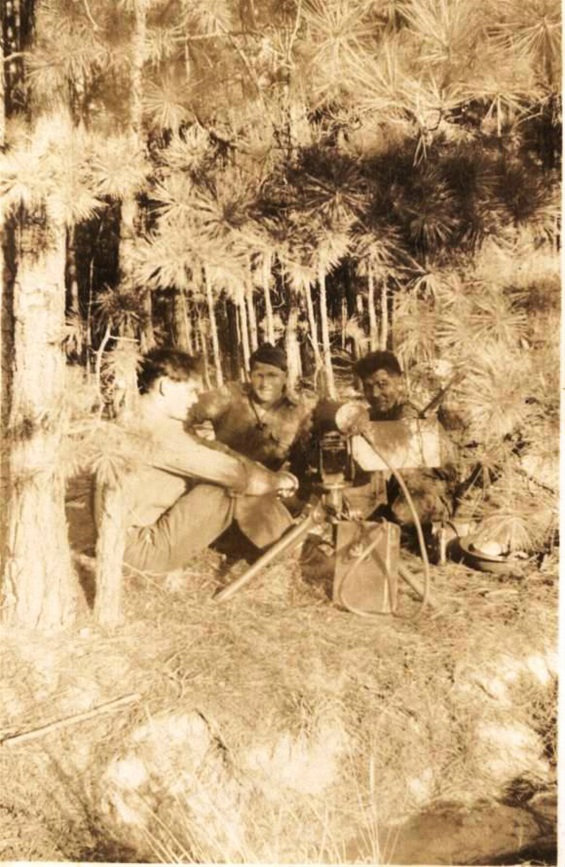 Browning water cooled machine gun training
Browning water cooled machine gun training
Official Unit History: Companies "A" and H&S to North Africa
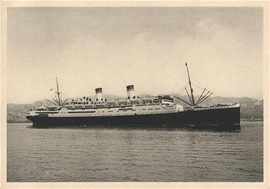 Company A sails for North Africa on the Monticello
Company A sails for North Africa on the Monticello
On March 9, 1943, the battalion was alerted for overseas movement. However, the alert instructions were later amended to include only one company and a detachment from Headquarters and Headquarters and
Service Company. Company “A” was designated as the company for overseas duty and it departed April 19, 1943 for the staging area at Camp Kilmer, N. J., with 1st Lt. R. D. Paterson commanding the company. - 5/7/43 Allies take Tunisia. - 5/13/43 German and Italian troops surrender in North Africa.
The detachment from
Headquarters and Headquarters and Service Company, consisting of Major Perdue, Captain Porter, 1st Lt. Brand and 37 enlisted men departed May 30, 1943 for the staging area at Camp Shanks, N.Y.
On
29 April 1943, Company “A” of this organization sailed from the New York Port of Embarkation and arrived at Oran, North Africa on 11 May 1943. A detachment of Headquarters and Service Company sailed from the New York Port of Embarkation on 10 June
1943 and arrived at Oran, North Africa eleven days later. On 23 June 1943, the Detachment joined Company ‘A’ seventeen kilometers east of Mostaganem, Africa on the Cheliff River.
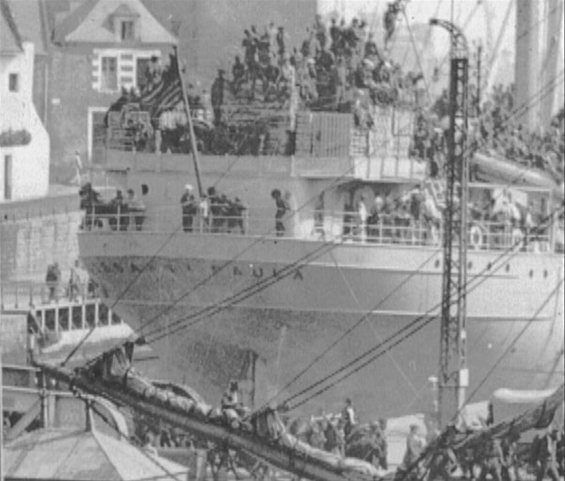 H&S Company sail to North Africa on the Santa Paula
H&S Company sail to North Africa on the Santa Paula
Monticello and Santa Paula
USS Monticello
AP-61
Displacement: 25,000 t.
Length: 651'10"
Beam: 72'6"
Draft: 26'7"
Speed: 21.5 k.
Complement: 494
Troop
Capacity: 751
Armament: 1 5"; 6 3"
The Monticello (AP-61) was built in 1928 as Conte Grande by Stabilimento Tecnico, Triestine, Trieste, Italy; as an Italian-flagged ship, interned in Brazil at the opening of World War II; purchased on
16 April 1942 by the United States; and commissioned the same day in Brazil, CAPT Morton L. Deyo in command.
Monticello sailed north for conversion to a transport at Philadelphia, completed 10 September 1942. She left New York on 2 November for
the invasion of North Africa, carrying troops to Casablanca. Returning to New York, she sailed again on 25 December, carrying men for the various commands of the China-Burma-India Theater to Karachi, by way of the Panama Canal, Australia, and Ceylon.
The transport returned to New York on 24 April 1943, carried reinforcements to Oran on two voyages, then sailed from Africa to San Francisco by way of the Panama Canal. Through the first half of 1944, she carried men from San Francisco to Californian ports,
Australia, Hawaii, and the burgeoning bases of the South Pacific. In June 1944, she began the first of a series of transatlantic voyages bringing men to win victory in Europe, operating with a Coast Guard crew after 6 August 1945. She decommissioned at Norfolk
on 22 March 1946 and returned to the War Shipping Administration for disposal on 27 May 1946. She was returned to the Italian government in June 1947.
Source: Dictionary of American Naval Fighting Ships
The USS SANTA PAULA, AP-157, was
the troop ship which carried an element of Headquarters and Service Company, 85th Engineers to North Africa. The Santa Paula was built in 1932 and had been a luxury cruise ship with a capacity of 228 passengers. After conversion it carried approximately 3,000
troops. Single or double occupancy cabins were modified to hold six to nine officers, and the enlisted men slept in bunks stacked four to six high, built so close together that the men had difficulty even turning over. On-board the men passed time by reading,
playing cards, talking, and practicing fire and general alarm drills.
Source: Health Sciences Library, University of Virginia
 Unit Journal entries showing Company A aboard the Monticello.
Unit Journal entries showing Company A aboard the Monticello.
Official Unit History: Parent Unit deployed
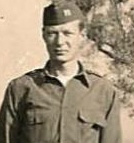 Captain Nagel. On 26 February, Major Burleson was ordered to 327th Engr (C) Bn this station and Captain Nagel assumed command of the parent unit as it sailed for North Africa.
Captain Nagel. On 26 February, Major Burleson was ordered to 327th Engr (C) Bn this station and Captain Nagel assumed command of the parent unit as it sailed for North Africa.
(State side - parent unit) 1st Lt. W. F. Darges assumed command of the battalion on May 30, 1943. Lt. Darges was ordered to duty with Air Corps at San Antonio,Texas, June 15, 1943 and 1st Lt. W. A. Lowry
assumed command.
On June 19, 1943, Lt. Col. John E. Mosley from the 1110th EngineerGroup, temporarilly stationed at Camp Polk, La., was assigned and assumed command of the battalion.
During the early part of the summer this organization received about fifty fillers (enlisted personnel) from various replacement depots. Many of these men came from other than engineer centers and have
had very little, if any, knowledge of what was expected of them in a unit of this type. This necessitated a complete introductory course in all types of equipment used by this organization. Red River (Slate Shoals) offered some ponton sites but the construction
of a dam at Denison and a very dry season made these sites almost of no value for training. Lake Crocket (Honey Grove) was selected and proved to be an excellant site for outboard motor training and storm boating. It also offered good sites for ferry landings
and ferrying. Concurrently with this training, drivers school, carbine instruction and firing, foot marches, Bailey Bridge construction and some specialist schools were conducted.
(State side
- parent unit) November 1943, this organization was ordered to participate in the 5th Phase, Third Army Maneuvers, (La) and left home station(Camp Maxey) on 29 November, arriving at Burr Ferry (La) on 30 November. Several days were spent in reconnaissance
for appropriate sites and two suitable ones were found. The area assigned to this unit extended from Burr Ferry north on the Sabine River to Toledo. Considerable training was accomplished in ponton bridge construction both by day and by night. On 5 January
1944, Lt. Col. Mosley left this unit and assumed command of 1124th Combat Group, Cp Maxey. Major Burleson assumed command. The maneuvers were completed on 24th January and the unit left the maneuver area for Camp Swift, arriving there on 29 January. Almost
upon arrival, unit was placed on an alert status for overseas movement and proceeded to make arrangements necessary to comply with orders for units in this category. On 26 February, Major Burleson was ordered to 327th Engr (C) Bn this station and Captain Nagel
assumed command.
(State side - parent unit - transit to North Africa) Unit (10 Officers, 3 Warrant Officers, 204 EM) entrained at Camp Swift, Texas on 19 March 1944; destination Camp Patrick
Henry, Va. (Staging Area) Upon arrival at Staging Area on 22 March, unit proceeded to make final arrangements necessary for departure overseas. On 29 March organization left Staging Area for Hampton Roads Port of Embarkation and embarked on U. S. S. Gen. W.
A. Mann. Entire organization was assigned all Military Police duties aboard ship for entire voyage. The performance of this assignment afforded all members of this command an opportunity to view the workings of a fine ship. Crossing took about ten days, the
destination was Casablanca, North Africa. Arrived port (Casablanca, N.A.) 9 April 1944, debarked and convoyed by truck to Camp Don B. Passage (approx 3 mi SE of Casablanca). Unit left Camp Passage 11 April, entrained for Oran, Algeria. Two days were spent
enroute to Oran. Upon arrival at Oran, (13 April) unit was met by Major Perdue. Unit detrained and convoyed by truck to Floating Bridge School, Pont Du Cheliff, Algeria. First two weeks were spent setting camp area in order and arranging various training schedules
necessary for maintianing and supervising a series of schools in technical phases of heavy ponton bridging.
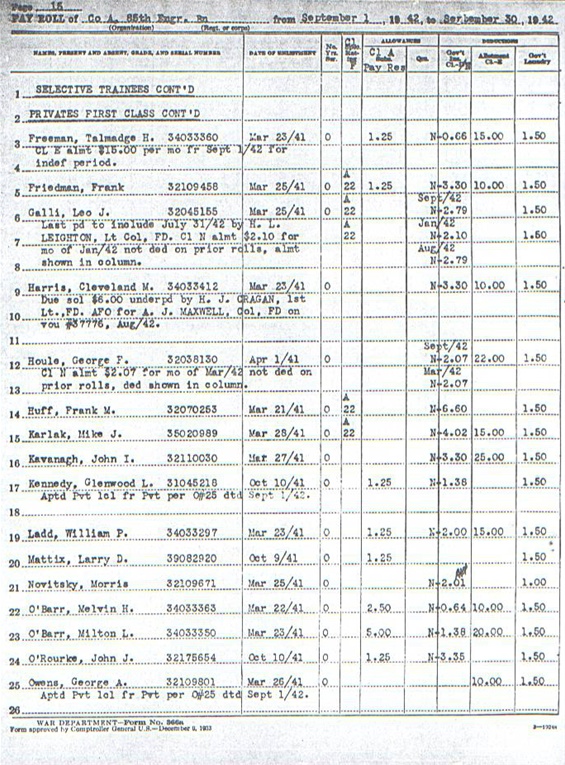 This is a page from the payroll records of the 85th Engineers, dated 9/1/42 to 9/30/42. The Engineers were quick to say, "We made $20 a day once a month". It's interesting to note that the last column is a deduction for laundry. The next to the last column is net pay. The prior columns are deductions for insurance, etc...
This is a page from the payroll records of the 85th Engineers, dated 9/1/42 to 9/30/42. The Engineers were quick to say, "We made $20 a day once a month". It's interesting to note that the last column is a deduction for laundry. The next to the last column is net pay. The prior columns are deductions for insurance, etc...
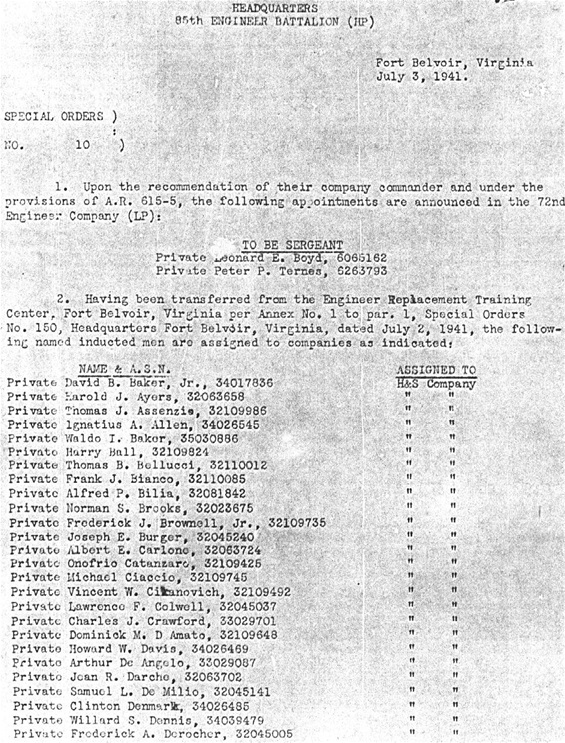 H&SCompany Roster 1941
H&SCompany Roster 1941
 H&S Company Roster 1941
H&S Company Roster 1941
85th Unit Rosters
Unit Rosters Company "A" The following
rosters are from various dates during the period 1941 - 1943. The first roster of the 85th was dated June 4, 1941, and listed one officer and six enlisted men.
First roster of the 85th,6/4/41: Capt: Stann, Eugene; 1st Sgt: Andrews, Robert; Sgt:
Dragan, Wassell; Stroko, Joseph; Cpl: Buzinski, Robert; Pfc: Frahulfar, Robert; Pvt: Hannssens, Phillip.
Medical Detachment, 6/30/42: Sgt: Ciccotelli, Mike; T5: Cox, Samuel; PFC: Mandich, Steven; Stoughton Walter; PVT: Brant, Elwyn; Dings, Robert.
Company A, Ft. Belvoir 3/31/42: 1st Sgt: Andrews, Robert; S Sgt: Jones, Edward; Seamans, William; Shryock, Samuel; Sgt: Buzinski, Walter; Campbell, Robert; Carlin, William; Connor, Everett; Perry, Horace; Ray, Robert; Reynolds, John; Rivet, Paul; Schimpf,
Joseph; Stroko, Joseph; Young, George; Cpl: Adams, Clarence; Backaus, Alfred; Blanton, James; Carter, Woodrow; Daniel, Hubert; Decker, Leo; Dwyer, James; Guba, John; Meyer, Bernard; Roberts, Norman; Salinas, Ricardo; Wiessner, Walter; Pfc: Abare, Leonard;
Anzelone, Lawrence; Austin, James; Bergman, Howard; Bonczyk, Stanley; Burkhalter, Edward; Buliteri, John; Cable, Robert; Candeloro, Lewis; Catatlano, Joseph; Dillard, John; Eannone, Salvino; Farmer, Roy; Ferris, Joseph; Fokianos, John; Fratello, Barney; Gentry,
Walter; Godek, Stephen; Gregorio, Henry; Harris, Cleveland; Harrington, Vincent; Houle, George; Hopkins, Samuel; Hudgins, Vaden; Huff, Frank; Johnson, James; Katz, Herman; Kavanagh, John; Karlak, Mike; Kramer, Leonard; Lawrence, Woodrow; La Forge, Leo; Lange,
Harry; Lynn, Kenneth; McCarthy, Daniel; Novitsky, Morris; O'Barr, Milton; Piper, Gordon; Pruitt, Robert; Raisner, Max; Sibener, Charles; Skulski, Walter; Skoros, Leonard; Smith, Clarence; Sommers, Alfred; Trimble, Clifton; Tubolino, Louis; Witkin, Ralph; Yotas,
James; Zabava, Adam; Pvt: Adams, John; Allocco, Andrew; Averett, James; Beck, Aloysius; Benowitz, Ralph; Biesiadecki,John; Bowman, Hugh; Boetcher, Vern; Boatright, James; Bodine, Charles; Brazell, Charles; Breloff, Carl; Brashier, RB; Bryant, Grady; Brewer,
Elbert; Byers, John; Cadieux, Joseph; Carr, Clifton; Carver, Ottis; Covey, Allison; Cowart, Lonnie; Davidson, Abraham; Day, Max; Della Sala, Ralph; Diamond, David; Di Pietro, Michael; Doss, Grason; Dragon, Wassell; Drumheller, Phillip; Dunzik, Arthur; Du Pont,
Bernard; Dugger, Dallas; Duevell, Walter; Dyer, Jack; Ellison, Jerome; Elker, Stanley; Enck, Martin; Fabanich, Michael; Farlow, Robert; Faulk, Guy; Faussett, Russell; Feldman, Harry; Freeman, Talmadge; Friedman, Frank; Galli, Leo; Gardner, John; Green, Harry;
Harbison, Charles; Hawkins, Clarence; Hertzog, Frederick; Heslin, John; Holland, Henry; Houston, Edward; Hffman, Sam; Kennedy, Glenwood; Kent, Russell; La Violette, Charles; Ladd, William; Lane, Archie; Lantz, Chester; Lindan, Edmund; Love, Vernon; Lowenthal,
Robert; Lowe, Ralph; Margaglio, Fred; Mattix, Larry; Mayberry, Roland; O'Barr, Melvin; O'Connor, Christopher; O'Rourke, John; Owens, George; Perdue, Earnest; Peterson, Harry; Peters, Paul; Pitti, Jerry; Pomella, Marvin; Rappaport, Samuel; Reiter, Cory; Reagon,
Fred; Rinks, Watson; Robertson, Charles; Sinclair, John; Skinner, Willis; Smith, Gerald; Speck, Albert; Stockman, Albert Jr; Toole, Robert; Troglen William; Tschetter, Bernard; Urtnowski, Herman; Van Langen, Allen; Vielhauer, Richard; Wolters, Arnold; Woolery,
Leonard; Wolters, Arnold; Zielenski, Louis; Zverina, Michael; Reagon, Fred; Meadows, William; from other organizations: Pfc: Cornelius, Loland; Kapraal, Francis; Pvt: Stroup, Ernest.
Company A, Camp Maxey 3/31/43: Regular Army: Sgt: Jones, Edward;
T4: Love, Vernon; T5: Averrett, James; Reynolds, John; PFC: Rinks, Watson; Casebolt, Glen; Pvt: Cadieux, Joseph; Gardner, John; Engineers: 1st Sgt: Bonczyk, Stanley; S/Sgt: Backaus, Alfred; Carlin, William Jr; Carter, Woodrow; Daniel, Robert; Godek, Stephen;
Seamans, William; Sinclair, John; Sgt: Breloff, Carl; Carr, Clifton; Eannone, Salvino; Fausset, Russel; Hudgins, Vaden; Roberts, Norman; Witkin, Ralph; T4: Dillard, John; LaForge Leo; Pruitt, Robert; Speck, Albert; Stockman, Albert; Urtnowski, Herman; Beck,
Aloysius; Burkhalter, Edward; Hertzog, Frederick; Katz, Herman; Kramer, Leonard; Lindan, Edmund; Mayberry, Roland; Trimble, Clifton; T5: Gregor, John; Johnson, James; O'Barr, Melvin; Smith, Gerald; Troglen,William; Walters, Arnold; Yotas, James Jr; PFC: Abare,
Leonard; Adams, John; Anastasi, Peter; Angelo, Dominic; Biscardi, Peter; Buliteri, John; Candeloro, Lewis; Catalano, Joseph; Cone, Auther; Cooke, Charles; Cowart, Lonnie; Davidson, Abraham; Deal, Carl; Della Sala, Ralph; DiPietro, Michael; Doss, Grason; Duksoz,
Willaim; Kiker, Stanley; Ellison, Jerome; Farlow, Robert; Gregorio, Henry; Houle, George; Huff, Frank; Karlak, Mike; Kavanagh, John; Kennedy, Glenwood; Kent, Russell; Kneider, Charles; Knorr, Chester; Krajacic, John Jr; Ladd, William; Lowenthal, Robert; Marsh,
Elwin; Novitsky, Morris; O'Barr, Milton; O'Rourke, John; Perry, Horace; Peterson, Harry; Pickering, Myron; Puto, Steve; Wiles, Maurice; Woolery, Leonard; Zielenski, Louis; Pvt: Amendola, Sol; Angelo, Dominic; Arp, William; Bates, Cap; Belton, Denzel; Boatright,
James; Burrows, Paul; Campbell, Joseph; Case, Albert; Connolly, Joseph; Cox, Robert; Daniel, Lige; Davis, George; Davis, Restie; Dawson, Thomas; Diamond, David; DiBisio, Anthony; Donabella, Anthony; Drumm, John; Fabanich, Michael; Faulk, Guy; Ferris, Joseph;
Fossum, Robert; Gentry, William; Gessner, Raymond; Gibson, Everett; Gibson, Jeff; Grantham, Buster; Hall, Dennis; Hallings, Charles; Harlan, Stanley; Harrison, Willaim; Hawkins, Clarence, Hayes, Ralph; Hendrix, Moultrie; Henry, James; Henry, William; Heslin,
John; Hicks, Harvey; Houston, Edward; Joe, Frank; Johnson, Stanton; Jurezenko, Joseph; Khouri, John; Laky, Alex; Lashley, Isacc; Loomis, Leonard; Love, Ralph; McEnaney, Edward; McNair, Edgar; Mannon, Rockard, Maxwell, Henry; Minnix, Charles; Meyers, Frank;
Peterson, Harry; Pranguber, James; Reese, Sam; Ricci, Nicholas; Rogers, Richard; Schmidt, Peter; Shughart, Melvin; Sermant, William; Sinclair, William; Smith, Woodrow; Smith, Russell; Skoros, Leonard; Souter, Eli; Snyder, Leon; Stucker, William; Tommerup,
Melvin; Warren, Melvin; Watson, Wiley; Wiehmann, Gilbert; Winter, Ferdinand; Zwerina, Michael.
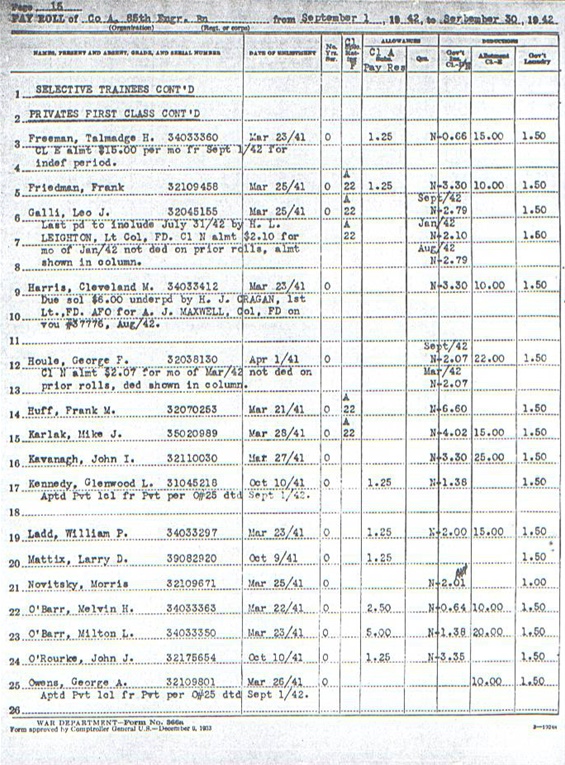 Payroll record
Payroll record
|
|
 |
|
|
|